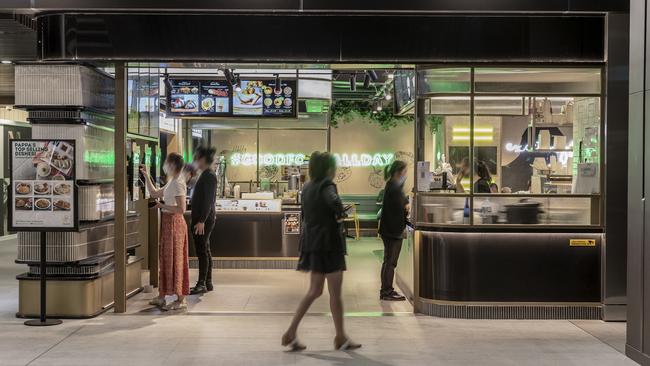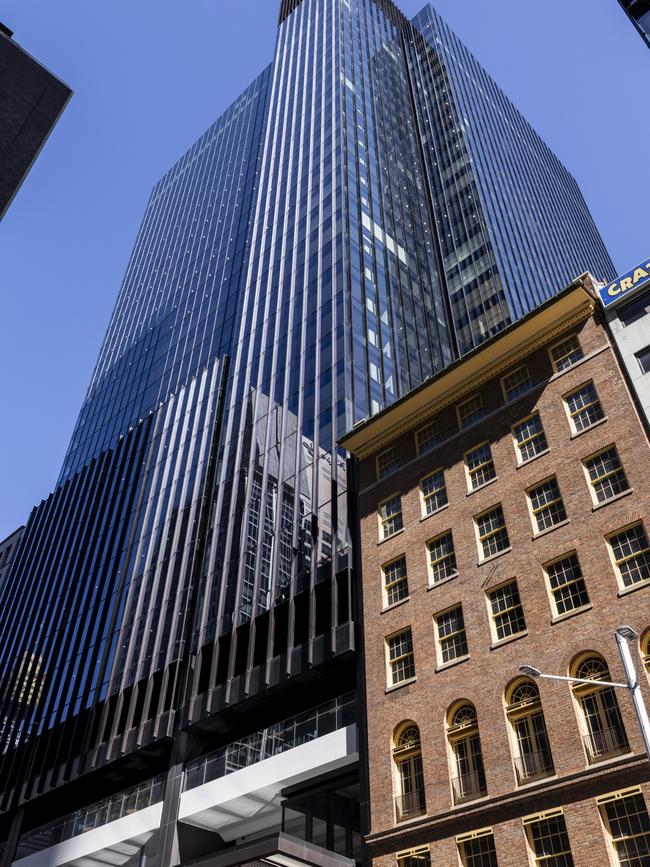Developers have bookmarked ghost kitchens, collabs as food retail’s future
Four menus, one grill. The new emerging food and beverage trend that’s a dream come true for property developers.

As the nation looks to continue its work-from-home arrangements, food and beverage operators are adapting to a wave of new trends forged within lockdown.
One that Brookfield Properties vice-president Danny Poljak has thrown his weight behind is multi-restaurant collaborations.
A first-of-its-kind, four-in-one restaurant has now opened in the new $2bn Brookfield Place precinct above Sydney’s Wynard Station. Behind the innovative new spot, which sees one kitchen cook for four outlets, is Allan Lam, a restaurateur from Hong Kong who operates several cafes and bakeries across the city.
His newest venue, PappaRich x Nene Chicken x Hokkaido Cheese Tart x Kurimu, is already proving popular.
“It’s a game-changer,” he said. “Since opening, from my perspective, the customer average spend has gone up.”
Multiple choices is almost expected given the options diners have when ordering from home, he said, adding that multi-venue kitchens are a common theme in Hong Kong.

“In Australia, in some instances, operators would carve a tenancy into four shops, but you’d be forced to have different staff with four different dishwashers and four cooking lines, which is just a logistical nightmare,” he said.
Mr Lam’s idea to combine restaurants is linked to a greater trend in commercial property, which Mr Poljak said would take the city by storm.
“I think you’ll see a lot more retailers innovating and trying to drive that experience and connection with customers,” he said.
Mr Poljak said the collaboration of multiple venues paid homage to Wynyard station’s history. “There used to be original refreshment rooms built in the 1930s here, and they make part of that inspiration, where we wanted to collaborate with retail tenants that cater to that diverse customer base, for office workers, city residents and those passing through,” he said.
Another trend this year is “ghost kitchens”, a popular front among delivery service providers.
Inside these largely unassuming spaces, also known “dark kitchens” or “cloud kitchens”, orders aren’t taken at the table or hand-delivered to the chef or put into a point of sales system to be paid for later. Rather they arrive via a ring on a tablet, bound by a timer to which the operator has to respond.
Once confirmed, chefs walk a few metres back to the wok, oven, grill or bench and prepare food. It’s packaged and placed in a little brown bag that will spend a short time in an insulated bag – carried by a driver, motorcyclist or cyclist – before being delivered to the customer.
A spokesperson for Uber said “ghost kitchens” and virtual restaurants we’re growing on its platform.

“We’ve seen success stories from restaurant partners that have gone on to have online sales on Uber Eats where the virtual brand exceeds their primary restaurant,” they said.
These kitchens provide room for a brand to test a new idea before fully committing.
“Delivery-only kitchens are a unique and efficient way existing restaurants can creatively test whether a new range, cuisine type or dish has a product market fit,” Uber’s spokesperson said.
“In other instances restaurant partners have been so delighted by the online response that they have scoped building an additional physical storefront for their digital offering to capture foot-traffic as well as online orders.”
In the supermarket space, the ghosts – or, as the nation’s largest grocery store chain calls them, customer fulfilment centres – occupy a larger, multimillion-dollar space.
Woolworths operates five of them in Sydney’s Lidcombe, Mascot and Brookvale and Melbourne’s Notting Hill and West Footscray.

While in some instances they may replicate a normal supermarket, they’re not built for walk-in customers. Rather they serve as a space for staff pickers to prepare online orders for delivery. After online sales grew 50 per cent between July and December last year, accounting for 11 per cent of total supermarket sales, Woolworths decided it would open three more stores, with ghost supermarkets set to open in Brisbane’s Rochedale in June and Sydney’s Caringbah in August as well as Auburn in 2024.
Customers were increasingly turning toward convenience-based grocery shopping, said Woolworths e-commerce general manager Tamara Manasserian.
“We’re seeing more and more of our customers turn to the ease and convenience of online grocery delivery across Australia,” she said.
“To keep pace with this demand, we’re investing in efficient customer fulfilment technology and infrastructure to enhance our online capabilities and the quality of our service.”
You’ll see retailers innovating and trying to drive that experience







To join the conversation, please log in. Don't have an account? Register
Join the conversation, you are commenting as Logout